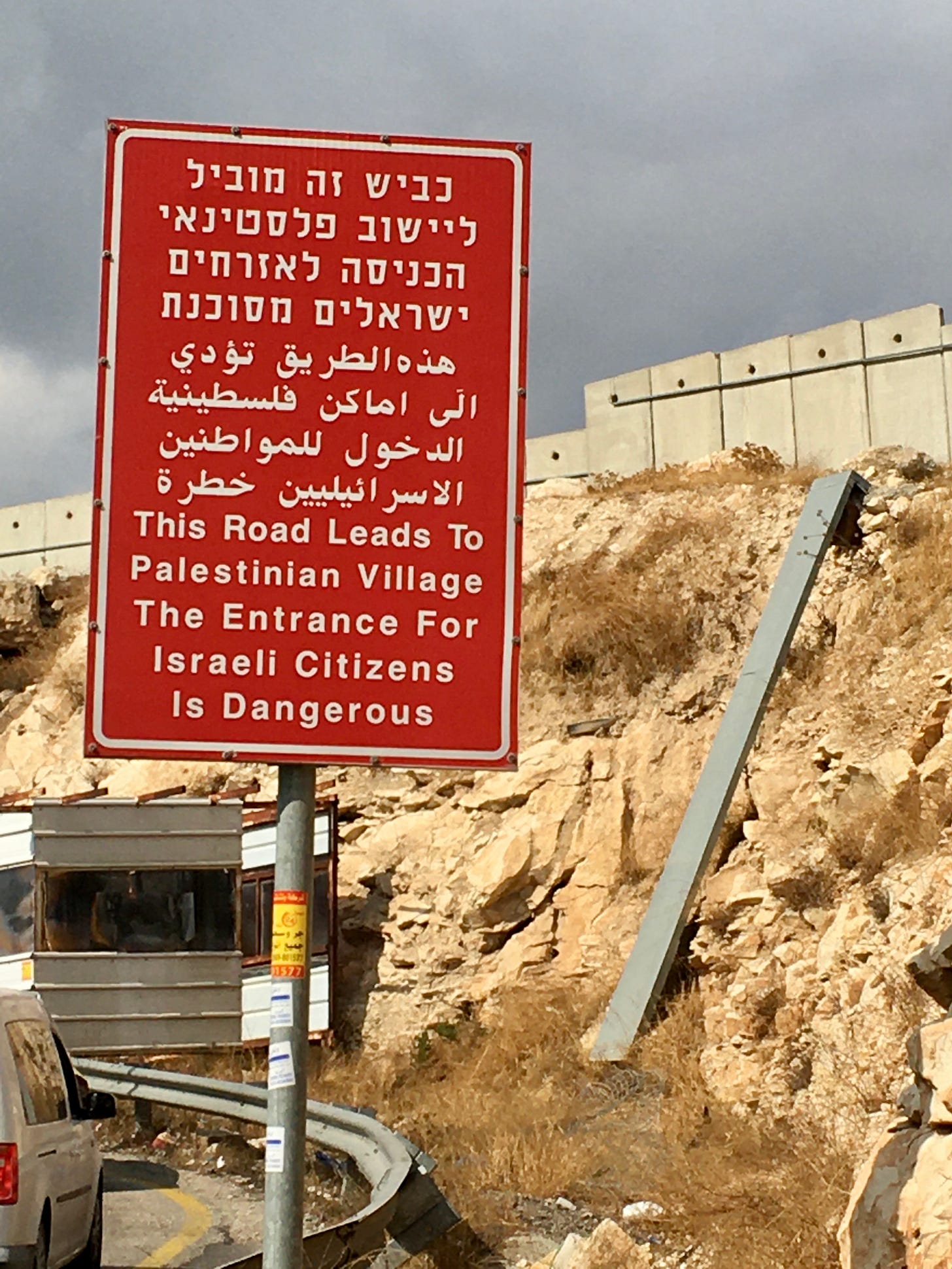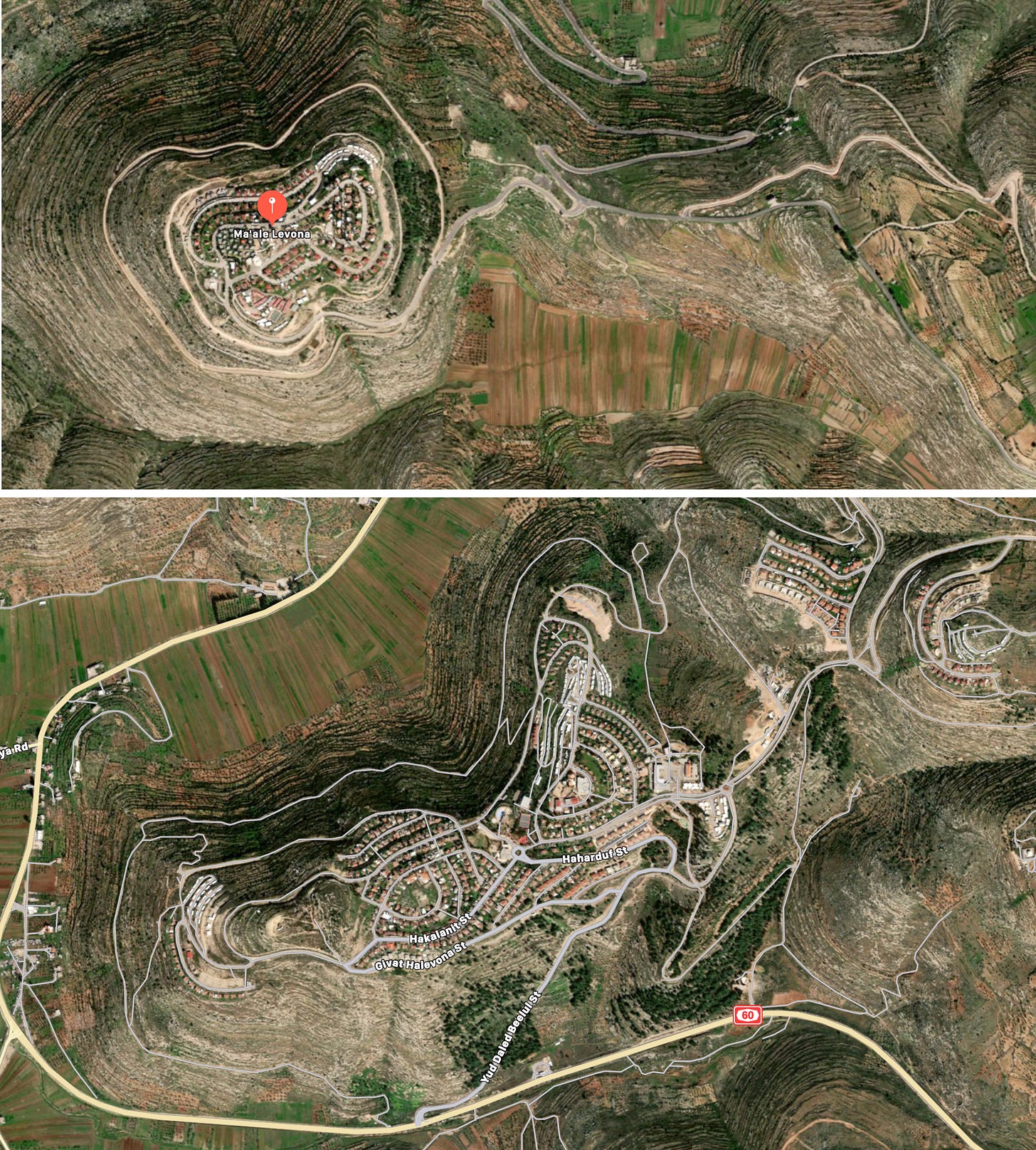Israeli settlements in colonized Palestine
There’s no possibility of a two-state solution. Zionists — and their American backers — made sure of that. I could see it from the window of our bus.
On the road outside East Jerusalem.
In our last episode we talked about Israeli settlements a bit, but I want to expand on the topic — and provide some visuals.
Last year Evgenia and I travelled by bus and shared taxi from Bethelham all the way to the northern edge of the West Bank, stopping over in Ramallah and Nablus, and then exiting through a border crossing on the outskirts of Jalameh — a spot that seemed to mostly be used by Palestinian laborers who worked on Israeli farms.
The roads we took ran through the center of this butterfly wing-shaped chunk of Palestine. It’s a mountainous area, and for much of the way the highway snaked through valleys surrounded by hills. We passed all sorts of Palestinian villages and cities. I knew that I’d probably see Israeli settlements on the way, but I was surprised by how many of them there were. I kept seeing them lining both sides of the highway as we headed north. Sometimes it felt like they occupied every major hilltop — built like fortresses on defensible positions, lording over the land below.
Two master-planned colonization communities in Palestine.
Sometimes — if a settlement was on a hill directly overlooking the highway — I could recognize it by sight from the bus. The security fences and stocky concrete towers were a dead giveaway. The ones that were farther away and out of my line of sight I could spot using the satellite view on Google Maps on my phone. Even without looking at their names, the settlements were very easy to recognize.
Seen from space, Palestinian villages and towns have an organic, chaotic layout — a sign that they developed and expanded naturally over a long period of time. Israeli settlements had a different type of vibe. They were logically and neatly laid out as one complete package, clearly built in one go. They kinda reminded me of the subprime “master-planned communities” that I got to know well out in Victorville, California: rows and rows of identical houses built according to a generic, mind-numbing suburban layout — the same cul de sacs, curving intersections, houses, and tiny parks and green spaces. There are miles and miles and miles of this kind of development out in California and the Southwest —entire deserts covered with identical houses, streets, neighborhoods, and corporate chains.
Out in Palestine, these master-planned colonization communities weren’t as huge or monolithic. They were smaller, boutique-ier. They were also a lot more militarized — built on defensible hilltops and surrounded by walls, security barriers, check points, fences, towers, gates, armed guards, and connected to Israel with slick, segregated roads designed for Israeli use, and which I could see from time to time out of the window.
Compare the organic form of the Palestinian city of Beit Faruk with Itmar, an Israeli settlement established in the 1980s by religious Jews. Notice that Itmar sits on a hill overlooking Beit Faruk and is situated close to what looks like a military outpost.
As our bus headed north I tried dropping pins on any settlement I could spot out the window. I also added nearby settlements that were just out of view, but which I could spot on the map. I didn’t get them all. But as you can see, we passed quite a few.
The settlements I was able to eyeball from my bus.
I’ve known that Israel has been using these settlements to slowly colonize what’s left of Palestinian territory and make any sort of future Palestinian sovereignty over this land even more of a political impossibility than it already is. But I never looked at the issue very closely, so I assumed most of settlements were spread out and more or less close to the border. Sitting there on the bus I was surprised how dense they were and how deeply some of them had penetrated into the interior — some of them were closer to the border with Jordan than with Israel.
Palestinian sovereignty beyond the Green Line? A future two-state solution? How the hell can you do that with Israeli settlements, Israeli-only roads, and Israeli military outposts built all over the place. There’s no disentangling it anymore. There is no two-state solution. Israel and its American backers made sure of that with all the settlements they built. I knew all this in an abstract and intellectual way before, but seeing it with my own eyes — even just from a bus window — the reality of it hit me hard…like a bolt from VALIS.
And the pins I dropped on the map above? Well they represent a tiny fraction of all the Israeli colonization settlements — many of which are even deeper inside the West Bank and run right along the Jordanian border. And, of course, they’re all connected by Israeli roads and electricity and water infrastructure and all sorts of military bases. Some of these illegal settlements are well-established towns, others are little more than trailers filled with religious fanatics. There are also quite a few militarized agricultural colonies — doing a profitable export business on “Israeli” produce grown on top of bulldozed Palestinian villages. This isn’t an occupation — this is a colonization.
The burgundy dots are settlements, courtesy of Peace Now. The
While settlers zipped by on breezy segregated highways, the roads we were on in Palestine were small, rundown, and usually congested — I was told time and time again that any development in Palestine is choked and blocked by Israel. So while our bus slowly headed north, I had a lot of time on my hands to read up on the settlements we were passing.
We passed a few smaller Orthodox settlements and a larger one that’s home to a big community of Kahanites — fanatical followers of Meir Kahane, a Brooklyn rabbi and anti-Soviet activist who founded the Jewish Defense League, worked as an informant for the FBI, and whose followers bombed Soviet and Palestinian offices and performances in the United States, including in New York. His outfit was eventually designated as a terrorist organization here and he had to flee to Israel, where he had the backing and admiration of the Mossad and a big chunk of Israel’s establishment. He was a real character — a conman and a blood-and-soil Jewish fascist. Which is why Jeffrey Goldberg, the current editor-in-chief of The Atlantic magazine, had such a big Kahane crush.
Ariel sits next to the Palestinian city of Salfit.
Then was passed Ariel. I couldn’t see it from the bus because it’s located on one hill away from the highway, but we barely missed it. The settlement sits deep inside the West Bank and it’s also one the biggest here — with a population of over 20,000. And almost half the residents are Soviet immigrants…just like me.
I’ve written before how Israel was the first state to covertly support and inflame Jewish nationalism within the Soviet Union. Zionist leadership smartly saw the huge pool of Soviet Jews as an untapped demographic weapon. In the 1950s, Israel established a dedicated covert intelligence division — Nativ — to whip up Zionism in the Soviet Union and to figure out how to get that immigration wave going. The operation picked up steam after 1967, when Israel occupied the West Bank and began constructing settlements. You needed bodies to fill all that occupied land — and Soviet Jews were the perfect instrument to secure their biblical Zionist fantasies.
In the end, the op was a massive success. About a million Soviet Jews came to Israel by the early 1990s. And some of them ended up in settlements in the West Bank — in new Jewish-only communities built on top of paved over Palestinian villages.
Many Soviet immigrants — clueless and fresh off the Boeing — didn’t even know they were moving out of Israel proper and into illegal settlements in occupied Palestine. Many Soviet Jews spent years in poverty after emigrating — some even lived in tents because they couldn’t find jobs and couldn’t afford the rent. That’s where the settlements came in. Housing there was heavily subsidized by Israel, as was pretty much everything else in these colonial outposts. It was a cheap place to live — filled with new schools and new housing stock. So people happily moved.
And from then on, they staked their future and the future of their kids — not just on an apartheid Israel — but on an illegal settlement built on top of a destroyed Palestinian village next door to a despoiled and occupied people. No doubt all this helped push many of my fellow Soviet Jews into genocidal fanaticism against Palestinians — a people they’ve never even interacted with before coming to Israel. But I guess that was all part of the plan. Weaponize ethno-nationalism, make it a core cultural identity, and blend in plenty of fear, victimhood, and messianic entitlement — and what do you get?
—Yasha Levine








The settlements in Israel and the role of Soviet jewish immigrants in settling them: Yasha Levine takes up this topic based on his recent trip through Israel. Looking for easy solutions? Won't be found here.